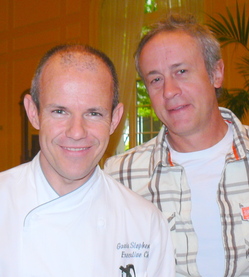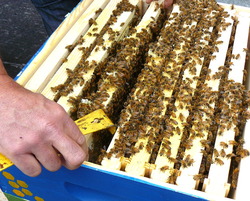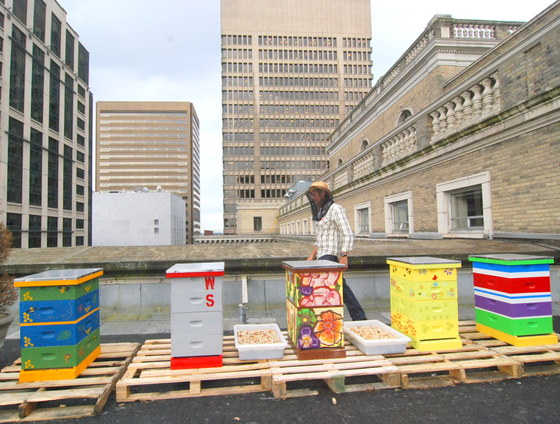Corky Luster, founder of Ballard Bees, with hives on the roof of the Fairmont Olympic hotel
It's the little things.
Ten thousand little worker bees, as it happens, plus one queen, inside a three-pound, $75 "box" of bees. Transfer contents into a 10-frame Langstroth hive and you're ready to take on the world.
Three years ago Corky Luster was a contractor installing Koehler fixtures. When the construction market softened, Luster looked for other ideas. He'd gone to WSU to become a vet and had done some beekeeping, so he started Ballard Bees with a couple of boxes in his back yard. Today the company has 85 hives, most of them in backyard gardens around town, and the homeowners--happy to have the advantages of bees (flowers, birds, seeing nature-at-work) pay him.
 Ballard's Bastille Restaurant and Kathy Casey Studios use his honey, but would beekeeping fly in downtown Seattle? Gavin Stephenson, executive chef at the Fairmont Olympic, came to Seattle with a mandate to expand the hotel's "lifestyle cuisine." Serving honey from the hotel's own hives was an attractive alternative to pasteurized commercial alternatives. He called Luster and they worked out a deal. Five brightly painted boxes went onto the roof, and, at the beginning of May, the hives were populated. By the end of the year, each hive will grow from 10,000 to 50,000 bees and eventually produce over 150 pounds of honey.
Ballard's Bastille Restaurant and Kathy Casey Studios use his honey, but would beekeeping fly in downtown Seattle? Gavin Stephenson, executive chef at the Fairmont Olympic, came to Seattle with a mandate to expand the hotel's "lifestyle cuisine." Serving honey from the hotel's own hives was an attractive alternative to pasteurized commercial alternatives. He called Luster and they worked out a deal. Five brightly painted boxes went onto the roof, and, at the beginning of May, the hives were populated. By the end of the year, each hive will grow from 10,000 to 50,000 bees and eventually produce over 150 pounds of honey.
"A bee can forage in a six-mile radius," Luster says. "We don't know exactly where they go, but they're already coming back with pollen on their legs." Once bees find a particularly attractive site, they do a waggle dance inside the hive to tell the others how to get there. The first thing they do is dive straight down from the roof, then they make (you should pardon the expression) a beeline for their feeding grounds.  Trees, gardens, parks, p-patches, anything that blooms is a target. It's a short season in Puget Sound; the weather has to be above 55 degrees for these particular species (the Italian and Carniolian western European honey bees) to leave the hive. "But just wait until blackberry season!" Luster exlaims.
Trees, gardens, parks, p-patches, anything that blooms is a target. It's a short season in Puget Sound; the weather has to be above 55 degrees for these particular species (the Italian and Carniolian western European honey bees) to leave the hive. "But just wait until blackberry season!" Luster exlaims.
Seattle's a good place for urban beekeeping. Backyard chickens are everywhere. Goats? Well, not so much. But bees, not a problem. Luster has a two-year waiting list of households.
As exec chef, Stephenson oversees food service for 400,000 covers a year. The rooftop hives won't provide nearly enough honey. "What's important is that we're doing the right thing," he says.

Leave a comment